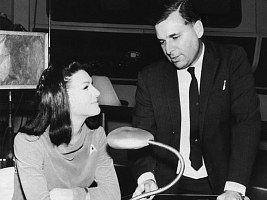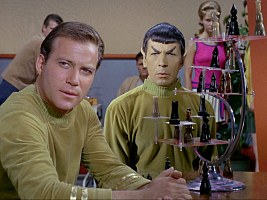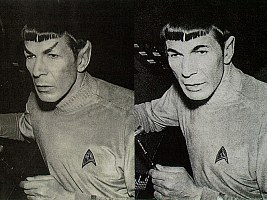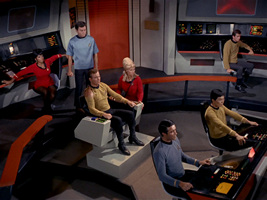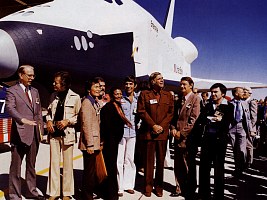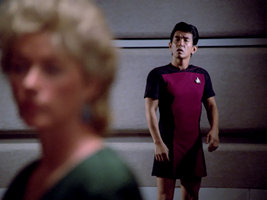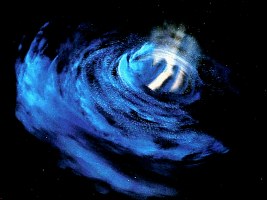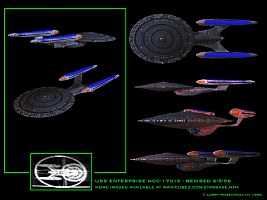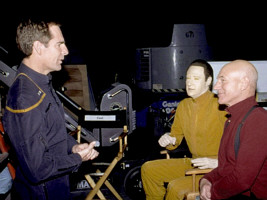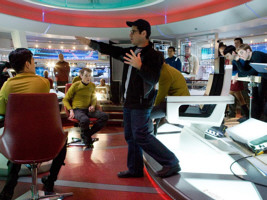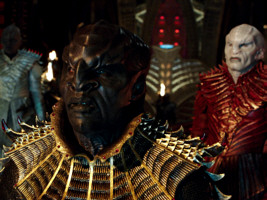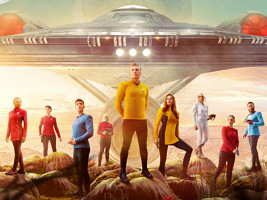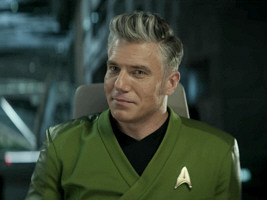A Short History of Star Trek
What is Star Trek? First of all, it is (as of early 2025) the entirety of eight live-action series, thirteen feature films, three animated series, a myriad of novels, many games and a vast amount of other merchandise. Star Trek is a brand, and has been among the most profitable franchises in the television and entertainment business for decades. However, there can be seen more in Gene Roddenberry's brainchild than just profit and an entertainment merit. It has become a seemingly indispensable benchmark, if not a vision, whenever people talk about the future of humanity, with all the technical as well as social progress it may entail. As part of our pop culture Star Trek may be the best-known and most often cited television series worldwide. And most importantly, a strong and very active fan base has been upholding the idea of Star Trek more loyally than any production company could do.
My brief illustrated history is composed of facts and observations that I personally deem noteworthy, so please don't expect it to be complete and neutral. The history of Star Trek fills many volumes and has been more comprehensively described elsewhere.
Space Seed
First Star Trek pitch, 1964
Gene Roddenberry (1921-1991) has worked as an Air Force pilot, a civilian pilot and a policeman in L.A. when his passion to write for television becomes his main occupation. He successfully pitches the idea for a series he calls "Star Trek" to the Desilu Studios in 1964.
His draft looks somewhat different than the Star Trek we are familiar with today. The lead ship is named S.S. Yorktown and is commanded by Captain Robert M. April. The descent of Spock, the only character who would eventually become a series regular, is described as being "half Martian".
Roddenberry places particular emphasis on the concept of "parallel worlds", of planets that are so much like Earth that they can be filmed taking advantage of existing sets and locations - apparently rather an economical concession than a part of his vision. The draft also includes the infamous nonsensical version of the Drake equation that Roddenberry fabricates to demonstrate how many alien civilizations are only waiting to be part of a TV drama. Some of the script outlines in the document will later be made into Star Trek episodes, mostly with different titles, just like a script provisionally titled "Mr. Socrates" will become TOS: "Bread and Circuses".
"The Cage", 1964-1965
The studio accepts Roddenberry's proposal. Sets and the model of the USS Enterprise NCC-1701 are built, and a pilot movie titled "The Cage" is shot to be sold to one of the major networks. Jeffrey Hunter plays Captain Christopher Pike of the Enterprise, a convincingly strong yet little charismatic lead character who is subjected to illusions induced by the vastly advanced Talosians.
Aside from the already legendary reproach of being "too cerebral" there are two more things that the officials at NBC purportedly do not like about the pilot: "Number One", the female first officer, and the alien officer, namely Mr. Spock. It is the 1960s, and they can neither put up with a woman in charge in a military rank structure, nor with Spock's "satanic look". When they give their blessing to a second pilot nonetheless, for the first time in TV history, Gene Roddenberry decides to dispose of "Number One" (played by his future wife Majel Barrett) in favor of Mr. Spock.
On a side note, Majel Barrett is later credited as M. Leigh Hudec (her maiden name) for "The Cage". This happens because Roddenberry needs to conceal that the actress would appear in a different role (and camouflaged with a different hair color) in Star Trek, namely as Nurse Chapel.
Second Chances
"Where No Man Has Gone Before", 1965
William Shatner as Captain Kirk replaces Captain Pike, while Leonard Nimoy reprises his role of Spock for the second pilot episode, "Where No Man Has Gone Before". Here the crew of the Enterprise have to struggle against fellow crew members who have gained god-like powers. This more action-loaded installment of Star Trek finds the support of the network directors. Still, not everyone seems to believe the time is right to have regular alien characters on a TV show. For an early leaflet Spock's ears and eyebrows are retouched to look human again.
Among several more points Gene Roddenberry emphasizes one groundbreaking quality about Star Trek already in his first draft: "The first such concept with strong central lead characters plus other continuing regulars". Captain Kirk, the determined leader with fine social skills (the latter not only relating to women) will become the possibly most famous character of a television series ever. Yet, Spock's role of an always sincere and, of course, logical officer will appear to many fans as the most intriguing, especially as he is occasionally torn between his human and his Vulcan heritage. But the two cannot yet be called complete as of the second pilot, with Dr. McCoy, contributing conscience and compassion to the mix, still missing.
Timeless
The Original Series, 1966-1969
The original Star Trek series premieres on NBC with "The Man Trap", actually the fifth filmed episode, on September 8, 1966. The troika of lead characters is complete now: Kirk, Spock and McCoy (DeForest Kelley). Their interaction is decisive in paving Star Trek's way to lasting success. It is safe to say that aside from its visionary concept and witty storylines, Star Trek, like every other TV drama, boils down to how its characters are written and played. Among the other characters Uhura (Nichelle Nichols), a black woman as a starship officer, epitomizes Roddenberry's vision of a diverse crew more than even Spock, although her role is kept relatively small. Speaking of diversity, we should not forget Sulu, Chekov and also Scotty, who inspires generations of engineers.
Humor, another key to a fine TV drama, has always been a part of the Trek lore. Be it unintentional like in TOS: "Spock's Brain", overdone like in "I, Mudd" or well-dosed like in "The Trouble with Tribbles", an all-time favorite of many fans, it always reminds us to take everything with a grain of salt. However, not in a sense that it should be consumed as mindless entertainment, but that it can be enjoyed despite and sometimes even because of its flaws.
Notwithstanding the commercial and social constraints Roddenberry successfully incorporates parts of his vision of a bright and peaceful future into the series. Kirk mentions almost casually that the Enterprise is a ship of the United Federation of Planets, an organization that is still one step ahead of the already utopian goal of uniting mankind. In Star Trek's 23rd century, racism has been overcome to a degree that a mutual understanding and eventually friendship can arise even between lifeforms that couldn't be more different. Unfortunately budget limitations and perhaps the critical eyes of the network directors who already wanted to reject the human-like Spock may prevent more stories with friendly aliens. But with gems like TOS: "The Corbomite Maneuver", "Arena", "The Devil in the Dark", "Metamorphosis" or "Let That Be Your Last Battlefield" Star Trek shows impressively that xenophobia can and must be overcome.
In this light, we may forgive the show that it sporadically kills hostile alien lifeforms without attempting to find a peaceful solution, like in TOS: "Obsession" or "The Immunity Syndrome". Yet, overall, it is very remarkable that The Original Series needs villains only on few occasions, and that many of them wind up as measly creatures like Trelane in TOS: "The Squire of Gothos" or the aliens in "Catspaw", not to mention the various computers that perish miserably like M-5 in "The Ultimate Computer" when Kirk reasons with them. While Star Trek may have borrowed whole storylines from Western series, space is largely devoid of black hats.
Isn't it remarkable how the communicators of TOS, created in a time when wireless communication is just a dream, resemble the mobile phones of the 2000s? Agreed, the finish of the props is rather coarse, but the idea is the same. And pertaining to computers, we have to bear in mind that the electronic library will become widespread reality as late as with the advent of the internet, more than 25 years after something similar can be seen on Star Trek. Taking advantage of a computer to control the ship's systems is another revolutionary concept as of the 1960s when they are only known as data processing machines fed with punchcards or with huge magnetic tapes. And speaking of storage media, the colorful insertable memory cards of TOS of the size of a 3.5-inch floppy disk have rather gained than lost credibility, considering that they may well be the 23rd century version of flash drives. Even storage disks closely resembling CDs appear in one episode, namely TOS: "All Our Yesterdays", although this is rather a coincidence than a vision.
Surely the writers or the set and prop designers like Matt Jefferies and Wah Chang have not predicted, much less invented any of these devices. Most of them have precedents at least in written science fiction, just as the transporter is in essence a generic teleportation device and the warp engines are not unlike other superluminal drives that Gene Roddenberry may have read about. But in Star Trek these concepts are visualized on television for the first time, and so impressively that Star Trek sets the standards for nearly all science fiction technology that has been devised until today.
That Which Survives
Syndication success, 1968-1977
During its three original seasons Star Trek is not blessed with high ratings. On the contrary, the show is on the verge of being canceled when a letter-writing campaign, led by Trek's most famous fan, Bjo Trimble, convinces the network to grant it a third season. But with Star Trek now being shown in the "death slot" late on Friday, it doesn't survive this final season. It is not before the syndication that the show becomes a nationwide and eventually worldwide success. And with an unprecedented lasting effect. In the 1970s, it seems that Star Trek is winning the more popularity the more time has passed since its cancellation. Fan conventions become a huge success. The enthusiasm culminates in another fan letter campaign that urges the NASA to call its space shuttle prototype "Enterprise".
A Star Trek sequel becomes due, but it takes some time for the TV stations and even for Roddenberry himself to notice that the idea bears potential.
The Animated Series, 1973-1974
Prior to returning with a live-action format Star Trek is made into an animated series (TAS), featuring the voices of the original cast. Many TAS episodes are admittedly mediocre; the course of the stories is often bumpy and they rely too much on tricks like "Deus ex Machina" to bring about a resolution. Overall, however, TAS pays tribute to the idea of Star Trek and continues almost seamlessly the five-year mission of TOS (or rather, extends it to a full five years). Some of the episodes are sequels to events of TOS. The episode TAS: "The Counter-Clock Incident" even includes Captain Robert April from Roddenberry's original draft of Star Trek. But the arguably best installment by far is TAS: "Yesteryear", telling the story of young Spock in a remarkably mature fashion.
TAS was not officially acknowledged as part of Trek's canon for a long time. "Yesteryear", however, was purportedly exempted from this ban.
The Next Phase
Phase II, 1977-1978
After a couple of fruitless efforts to bring Star Trek to the big screen (Gene Roddenberry has been talking about a feature film as early as 1968), Paramount approaches the Star Trek creator to revive the TV series in 1977. Roddenberry tries to gather as many of his former staff as possible for what is informally dubbed "Star Trek Phase II". Most of the actors would be able and willing to reprise their roles, except for Leonard Nimoy as Spock. New characters would be Commander Decker, Lieutenant Ilia and the Vulcan Xon, the latter obviously meant to replace Spock.
Several screenplays are available and pre-production of sets and models is done when the officials come to the decision to ditch Star Trek Phase II in favor of a big-budget movie - which may have to do with the success of "Star Wars". Anyway, the pilot episode of the would-be TV series, "In Thy Image", is made into the first Trek feature film, "Star Trek: The Motion Picture" - with Nimoy's participation.
TOS movies, 1979-1991
Ridiculed by some critics as a "slow-motion picture", the intelligently written movie "Star Trek: The Motion Picture" (1979) becomes a smashing success in the theaters nonetheless.
The second Trek feature film, "Star Trek: The Wrath of Khan" (1982), is made without direct involvement of Gene Roddenberry. It is obviously governed by the premise of appealing to a broader audience, and it includes more action to that end. But building upon the story of Khan Noonien Singh from TOS: "Space Seed" the movie is definitely a tidbit for die-hard Star Trek fans more than ever. Although "Star Trek: The Search for Spock" (1984) and "Star Trek: The Voyage Home" (1986) fall a bit short of the intensity of the duel between Kirk and Khan, the movie trilogy is still a fan favorite today. On the big screen the vastness of space becomes a stage for big emotions. However, until 2010 no Star Trek movie ever wins an Academy Award, not even in the purely technical categories.
Peak Performance
The Next Generation, 1987-1994
"Political Correctness", but in a positive sense, is a prevailing theme during the seven years of Star Trek: The Next Generation (TNG). It is reflected in rather small details like the change of the title monologue to "Where No *One* Has Gone Before", getting rid of the latent sexism that may lie in the word "man". Or in the "skant" (= skirt + pant), a unisex garment worn occasionally by low-ranking male crew members in the first season. Or in the carpeted floor on the Enterprise-D, even in engineering, which makes it look like a luxury cruiser and not at all like a warship. Also, there are now families aboard.
Strange lifeforms in TNG are regarded in the first place as a fascinating opportunity to expand knowledge, rather than being a potential threat - up to the point of self-sacrifice, like it almost happened in TNG: "Silicon Avatar" that resorted to a mad scientist as a scapegoat to kill the hostile crystalline entity. The idea of unquestioned tolerance for alien societies culminates with the concept of the Prime Directive. Although the directive evidently already existed during TOS, it plays a crucial role as late as in episodes like TNG: "Justice" and "Who Watches the Watchers?"
On the other hand, both aforementioned episodes are remarkable in that they include outspoken criticism of religion. The struggle against any form of religion (especially of the organized kind) has been a pet peeve of Roddenberry that infrequently resurfaces in Star Trek, most obviously during early TNG when he has more control of the franchise than ever before and after that.
In all of its incarnations Star Trek always retains its uniqueness, but just as well it reflects real-world developments. The Federation's fragile relations with the Klingons during TOS are quite obviously modeled on the ongoing Cold War between the USA and the Soviet Union. In TNG we see the former enemies as allies (on two occasions it even seems like the Klingon Empire is now a part of the Federation). It looks like the series, produced since 1987, anticipates the events that would change the real world a few years later - although it may be a bit far-fetched to call this visionary. Anyway, several TNG episodes made in the following years skillfully carry real political developments into Star Trek, like "Unification" of 1991 as Star Trek's take on the German reunification, to name one prominent example. And the movie "Star Trek: The Undiscovered Country" of the same year, the last one with the complete TOS crew (and a worthy conclusion after the awful "Star Trek: The Final Frontier"), shows the first step to the lasting peace between the Federation and the Klingons.
On October 24, 1991, Gene Roddenberry passes away at the age of 70. Having retreated from work some time before his terminal illness, the transition to his successor Rick Berman as executive producer of TNG is smooth. We can only speculate whether the rest of TNG is still in Roddenberry's sense, or whether he would have approved of DS9, a series with an often mystical theme. But it is also obvious that the legacy can only survive its creator if it remains flexible - as flexible as it is already described in the very first draft of 1964.
TNG garners no less than 15 Emmy Awards and is nominated for 55 altogether. More than ten million viewers tune in during TNG's fourth and fifth seasons, making it the highest rated syndicated TV series. Certainly the unprecedented quality of all aspects of the program contribute greatly to this triumph. But we must also bear in mind that in 1987 TNG is without serious competitors. This allows TNG to enter the mainstream of TV entertainment, whereas its sequels, now in competition with many other sci-fi formats, reside in a "geeky" niche once again.
Whilst TNG initially continued just where TOS left, it develops a distinctiveness at latest with the third season and dares to try out new forms of storytelling. Two-part episodes like TNG: "The Best of Both Worlds" with its legendary cliffhanger and story arcs are new to Star Trek. Many episodes are tied together in some fashion, and recurring enemies like Q or the Borg permit more concentration on the characters than isolated episodes in which it is necessary to first establish the setting to the viewers. The introduction of the holodeck opens even more new opportunities, as it makes possible any kind of story in any kind of environment without time travel or even resorting to a contrived explanation along the lines "it's just a dream".
The USS Enterprise NCC-1701-D, a new ship in a new era, calls for a new commanding officer - and Captain Picard (Patrick Stewart) couldn't be more different than James T. Kirk. Picard appears inhibited, even somewhat unfriendly at first. At the beginning of TNG it frankly doesn't look like his character would last more than perhaps two seasons. Wrong. Picard would develop to one of the most interesting figures in Star Trek - well-versed in many fields, benevolent and cautious yet always determined and sometimes refreshingly stubborn.
Like it was already in TOS, the crew is the heart of the series. Above all characters Data (Brent Spiner) continues to impress as an artificial lifeform who is much more than a walking lexicon. Data strives to become human like a galactic Pinocchio, and we can witness important steps of his progress over the course of TNG. There is also Worf (Michael Dorn) who starts off as an officer without obvious purpose and without much to say. He is developed to a character with facets so diverse as the whole Klingon culture which is prominently featured with its customs and its political intrigues in many TNG installments. Along with Riker, Troi, Geordi and Dr. Crusher they form what we could almost call the "Royal Family" of Star Trek. It seems everyone of the actors says that TNG was the best time of their life with a huge amount of fun, and I think we can see that on screen.
Prophet Motive
Deep Space Nine, 1993-1999
Two series are simultaneously on air for the first time in Star Trek's history when, during the height of TNG's ratings, a team around Ira Steven Behr and the late Michael Piller launches Deep Space Nine (DS9). Star Trek becomes literally settled when it moves into a space station, and unfortunately this is in part reflected in the often too slowly paced episodes of the first season. But the potential of the Bajoran people, their faith, the wormhole and the inevitable culture clashes between the various alien civilizations involved in the series will pay in the following years.
Even more than that, the characters around Benjamin Sisko (Avery Brooks) and his mixed bag of officers make even the less interesting stories an enjoyable experience. The father and Starfleet officer in the role of a religious idol, his volatile and often obstinate Bajoran first officer Kira Nerys (Nana Visitor) and the security chief Odo (René Auberjonois) on the search for his origin and his place in the universe are just the most prominent figures of the microcosm of galactic relations that is DS9. Add the recurring guest cast with often more important roles than most of the regular staff, and DS9 is a family series in the best sense. It is also a series that fans commit themselves to in order not to miss any part of the various story arcs. And the advent of the USS Defiant, a Federation starship of a different kind, in the third season compensates for the disadvantage of being too static.
Beginning in the fourth season, the Federation-Klingon conflict, Worf's transfer to the station and the following Dominion War bring an unprecedented amount of action and excitement into Star Trek, increasingly supported by computer-generated effects. Fortunately always to its advantage.
While real-world politics always had an impact on Star Trek story-wise, the franchise has remained largely unaffected by new trends in science fiction that have cropped up since the 70s. Most contemporary science fiction depicts a postapocalyptic world, a world ruled or corrupted by supranational companies, a mankind that has become addicted to technology, a seemingly endless war between galactic empires or a setting in which science and myths are blurred. Even Roddenberry himself subscribed to dystopian visions in the 1970s when he conceived "Genesis II" and two more unsuccessful pilot movies that are eventually made into "Andromeda". All of these concepts are certainly not bad, but they can barely relay a positive message. DS9 was admittedly close to leaving the ground of a humanity that is capable of building a better world. But ultimately the moral and ethical failings shown in episodes like DS9: "For the Uniform" or "In the Pale Moonlight" demonstrate that figures like Captain Sisko are just not bigger than life - which fictional characters in general rather shouldn't be in order not to become bland after a while and to remain credible in the first place.
Far Beyond the Stars
Voyager, 1995-2001
Star Trek Voyager carries on where TNG has left. But the sequel takes place in an uncharted region of space, on a Starfleet ship stranded in the Delta Quadrant, 70,000 light years away from Earth, that attempts to find a way home. Just as DS9 proves that Star Trek can work without a starship, Voyager can do without the familiar setting of the Alpha Quadrant.
One aspect of the show's premise is that the crew which consists of Starfleet and former Maquis rebels is forced to unite under the leadership of Captain Kathryn Janeway (Kate Mulgrew), the first woman to command a Trek starship in a permanent role. The ship also suffers from a permanent shortage of energy. Both problems fade away very quickly by the second season. The conflict against second-rate villains like the Vidiians and the Kazon is given much exposure, but the show really thrives on its character-focused thrillers like B'Elanna's struggle in VOY: "Dreadnought" against a machine she created herself, as well as on the discussion of ethical dilemmas like in VOY: "Tuvix" - even and especially if the outcome remains controversial. Another highlight of the series: "Distant Origin", a spirited statement against political and religious totalitarianism.
With the advent of the Borg and Seven of Nine (Jeri Ryan) in the fourth season Voyager becomes more action-heavy again. Although some of the "big" episodes like VOY: "Scorpion" or "Dark Frontier" are exceptionally thrilling, the general tendency of watering down the Borg menace and depicting Voyager as an übership is to many fans' displeasure. Scathing criticism is directed especially at Rick Berman and Brannon Braga, the executive producers of the series who, as it seems, neither pay much attention to continuity nor come up with novel ideas. Yet, it is undeniable that the interaction between the characters, not only Janeway, Seven and the Doctor (Robert Picardo) who become the writers' favorites, is always wonderfully well-rehearsed. When Voyager finishes its seven-year run on schedule, it has grown to a high-quality science fiction series with firmly established and very likable characters but has lost some of its original vigor.
For the Uniform
TNG movies, 1994-2002
The first movie with the TNG crew, "Star Trek Generations" (1994) is only a moderate success. In 1996, however, "Star Trek: First Contact" hits first the internet with new speculation and bits of information nearly every day, and later the theaters. It is not only the first movie with the Enterprise-E but also a Trek film of a new kind, made as a literally "dark" action thriller and not so much as what detractors like to call a "space opera" such as the previous feature "Star Trek Generations". Nonetheless "First Contact" becomes a fan favorite, an achievement that the following "Star Trek: Insurrection" (1998) and "Star Trek Nemesis" (2002) won't repeat.
The paradigm shift in fandom is even more palpable than the one on screen. Since the mid-90s, the internet has been influential in promoting the idea of Star Trek - and vice versa the opinion is widespread that Star Trek, besides free porn, brought about the internet in the first place. In any case, Star Trek has gained more recognition in the electronic media than in all newspaper reports and improvised printed fan publications combined. The internet lowers the distance between hundreds of thousands of fans who otherwise would only occasionally travel to conventions, if at all. It has brought the fans of RPGs, of games, of fan fiction, of artwork and of Treknology together. They can now work on common projects on a permanent basis, like on marvelous starship artwork or on the huge encyclopedia that is Memory Alpha. And they can discuss any time, initially in newsgroups, now in forums and chats. Even slash fiction, the weird idea that main characters like Kirk/Spock (hence "slash") are gay based on alleged evidence from the series, has found a permanent home in the web.
On the downside, the internet acts as an amplifier for all sorts of conflicts. The first schism occurred largely unnoticed when TOS fans rejected the idea of TNG. In the early internet age, however, groups of Voyager fans are at odds with "Niners", not to mention the pesky "Star Trek vs. Star Wars" debates. Even if these are only a small minority, at some point every fan inevitably runs into such outgrowth of what Star Trek is really about. In such an atmosphere, establishing the fifth series, Enterprise, in 2001 should turn out particularly difficult.
Tomorrow is Yesterday
Enterprise, 2001-2005
Since its initial announcement Enterprise, the Star Trek prequel series, is confronted with reproaches from fans of not adhering to established continuity. When the first pictures of "Akiraprise" NX-01 are published, observably no effort has been made to create a truly original design of the 22nd century. For many fans this, among other gripes, is a reason to disapprove of the show altogether before it even goes on air.
Certainly some of the apprehension turns out to be premature when the pilot episode, ENT: "Broken Bow" presents itself as great drama despite some flaws. While Enterprise is still struggling in the following to develop a certain distinctive feel of the 22nd century with respect to 24th century Trek, it matures to a wonderful series in its own right. The chemistry between the characters works well, and there are a number of outstanding stories if we ignore for a moment that we have seen most of them before. However, when the original concept of Enterprise seems to be exhausted, the series takes a detour as nearly the complete third season is dedicated to the fight against the Xindi, new archenemies that are pulled off thin air.
Anyway, at latest since the fourth season Star Trek Enterprise, now under the new executive producer Manny Coto, finally lives up to its original premise and promise - to show how it all began. Especially the Vulcan, the Klingon and the Romulan arcs are among the best installments of all Star Trek. Alas, owing to the ever dropping ratings - rather than the fans' continued moaning - it is already agreed on that the fourth season would be the final one.
Trekless time, 2005-2009
After Enterprise has come to an end in May 2005, it is the first time in 18 years without new Trek episodes. In a last attempt to avert the Trek-less time, a fan campaign is launched to keep the show on air. Saveenterprise.com, raising funds for the show, even receives a commitment, purportedly from aerospace industrials, to donate as much as three million dollars for Enterprise. The effort is in vain, as Paramount is not interested in such a deal.
Power Play
Abrams movies, 2009-2017
In April 2006, Paramount announces that J.J. Abrams, co-creator of "Lost", will produce a yet untitled eleventh Star Trek feature film. It is initially said to be a prequel with new actors playing the TOS crew, but Leonard Nimoy, as opposed to William Shatner, appears in his old role too. Abrams makes it clear that his movie is not primarily aimed at long-time fans.
The new movie by J.J. Abrams is simply titled "Star Trek". It is completed in summer 2008, but the release date is postponed from Christmas 2008 to May 2009. In November 2008 it becomes clear that "Star Trek" is set in a persistent parallel timeline, effectively rebooting the franchise. This, as well as some weird design decisions, leads to controversies in the fan community. But it also sparks new interest in the franchise, also in the mainstream media. "Star Trek" wins an Oscar for best make-up and receives rave reviews from most critics, who praise Abrams's directing and the actors' performances almost unanimously. However, not only fans have issues with the lacking substance of the story and with the countless plot holes of what is supposed to be a popcorn movie the in first place.
The second film of the series, "Star Trek Into Darkness" (2013), is just as exciting and suffers from similar problems. In addition, the decision to enlist a totally re-imagined Khan as a villain and re-enact parts of the fan favorite "The Wrath of Khan" is met with harsh criticism. On the financial side, on the other hand, the two films are hits at the box office. The production and release of the next movie "Star Trek Beyond" is overshadowed by the deaths of actors Leonard Nimoy (2015) and Anton Yelchin (2016). "Beyond" is praised by critics for bringing back some of the old spirit, but rather in the character interaction than in the lame story. It takes a long time for this third film to become finally profitable.
In the years after "Beyond", there are repeated announcements that a new movie with the cast around Chris Pine as Captain Kirk is going into production. A persistent rumor is that Chris Hemsworth is supposed to reappear as Kirk's father. Directors are nominated and then withdrawn. Even Quentin Tarantino is in talks with Paramount at some point, without him having a clue what the story could be about except that it will be R-rated. As of 2024, there are yet more new announcements but no real sign that there could be a movie any time soon.
The Emperor's New Cloak
Discovery, 2017-2024
In November 2015, more than ten years after the end of Enterpris, CBS announces the launch of a then still unnamed Star Trek TV series headed by Alex Kurtzman. Many fans are disappointed that the new show, Star Trek Discovery, will not air on the network but on the newly created CBS All Access pay channel in the USA, and on Netflix in most of the rest of the world. The production history of Discovery is bumpy. The premiere date is moved multiple times, and it turns out that series creator Bryan Fuller left the production after disagreements with the studio.
The producers reaffirm that the series is set in the traditional Prime Universe, not in the same timeline as the Abrams movies. But it soon becomes clear that Discovery does not respect the established canon of Star Trek, as most visuals as well as technologies and historical facts are concerned. The totally new Klingons are just the most obvious of the far-reaching alterations. The series is controversial already before it goes on air in September 2017, and it subsequently earns an additional bad reputation because of its ill-tempered characters, its overall negativity and its illogical storyline. Others praise Discovery as a visually appealing and exciting iteration of Trek for a new generation, and it becomes a hit series according to CBS.
Gretchen Berg and Aaron Harberts, who replaced Bryan Fuller as showrunners in season 1, are fired for being "abusive" behind the scenes while season 2 is in production. Alex Kurtzman, on the other hand, signs a five-year contract with CBS to further produce this and several more Star Trek series. Discovery's second season feels a little bit more like Star Trek, also and especially due to the addition of the familiar characters Pike and Spock. But in the end, the reconnection of the series to Star Trek's canon is only accomplished with steamroller tactics, by moving the ship out of sight, into the far future, and everyone being ordered never to talk about it. After the production has purportedly been delayed by the coronavirus pandemic, the first episode of the third season, set in the year 3188, airs on October 15, 2020. The fourth season continues in this new setting. The fifth and final season is produced in 2022/23 and airs in early 2024.
The fandom is still very divided over Discovery and, to lesser extent, over the other recent live-action shows. Some deny that the series should be considered a part of the Star Trek legacy at all. The other militant end of the spectrum decries any criticism of new Trek as "toxic" or "gatekeeping". Fans are compelled to pick a side and to remain silent on certain taboos, or they have to stay out of forums or social networks in which one of the extreme positions prevails. Discussions, in many media, have been reduced to mutual affirmations that are either like "yeah, it all sucks ass" or "yeah, greatest Trek ever". In other words, the discourse is dead. As already mentioned, some fans clashed over the right course of the franchise already 20 years earlier, but the formerly unpleasant exception of clash of irreconcilable opinions has become the normal insanity of today's internet fandom.
Section 31, 2025
On January 14, 2019, Alex Kurtzman announces a Discovery spin-off series to feature Michelle Yeoh as emperor-turned-operative Philippa Georgiou. The idea that a genocidal dictator, now working for a lawless organization, would be the central character of a Trek series triggers mostly negative reactions in the fandom. The production goes on regardless but drags on for years, until the series is condensed to a streaming movie. "Section 31" is released on January 25, 2025. The movie is almost universally slammed, even by the access media, for being a bland generic action flick with the label "Star Trek" slapped on. Arguably no other Star Trek production in history had such a bad press. It is yet to be seen whether the total misfire will have consequences for ongoing or planned productions of the franchise.
Once More Unto the Breach
Picard, 2020-2023
At Star Trek Las Vegas on August 4, 2018, Sir Patrick Stewart surprisingly appears on the stage and announces that he would return in his role as Jean-Luc Picard. For many fans who dislike the lack of continuity and of ethos in recent Trek productions, this new show is a spark of hope, especially since Alex Kurtzman describes it as "contemplative". It soon becomes clear that Star Trek Picard, as the series is simply titled, will respect the established canon but will show a very different Jean-Luc Picard in a world that has changed for the worse.
Picard first airs on January 30, 2020, on CBS All Access. To the chagrin of many international fans, the international distribution of the series is on Amazon Prime and not, like Discovery, on Netflix. Picard is set in the year 2399, more than a decade after a nova destroyed the planet Romulus and after Admiral Picard's large-scale rescue operation failed because of sabotage. The outcome at the end of its first season is that the series is different than Discovery, but it suffers from mystery-mongering, from a dystopian setting and from the deconstruction of Jean-Luc Picard, the arguably most beloved character of the whole franchise. While the series receives positive reviews on average, it does not manage to bridge the rift that has formed between classic and new Trek. The second season suffers from a time travel storyline that is dragged out and from numerous manufactured coincidences.
The launch of the third and last season is accompanied by a media hype because Jean-Luc Picard is reunited with his bridge crew from TNG and because several advance reviews almost unanimously praise it to the skies. Although the clear consensus is that this is the best season of new Trek, there are several points of criticism. Many fans dislike the totally overdone darkness of the sets and the lack of progress in the first couple of episodes. But the most substantial point is that the narrative shift in the last two episodes more or less collapses the arc of suspense that has been built. Anyway, after this undoubtedly most successful season of post-2005 Star Trek, many fans hope for a new sequel series, which Picard showrunner Terry Matalas tentatively named Star Trek Legacy. But it is not going to happen.
Lower Decks, 2020-2024
Lower Decks is the first official animated Star Trek since 1974, and the first Star Trek-based comedy show. Its season 1 goes on air on August 6, 2020, in the USA and in Canada. Fans in other countries are initially locked out because no international distributor is found. The series later finds it way to Amazon Prime. Lower Decks presents itself as a comedy grounded on Star Trek, rather than a parody of the franchise. Creator Mike McMahan even states that his series is canon. On the visual side, Lower Decks faithfully recreates the world of the TNG-era. The series is about lower-ranking personnel on one of Starfleet's less important ships, a premise that was obviously chosen to contrast this with the high-profile missions of the USS Enterprise and its crew. References to how much better and how much more desirable the Enterprise is are ubiquitous in the show for that matter. Overall, the series pokes fun at Star Trek clichés, sometimes more and sometimes less aptly, but mostly respectfully.
Although the series is very popular, its fifth season in 2024 is the last one.
Prodigy, 2021-2024
Star Trek: Prodigy, a second animated series, launches on October 28, 2021 on Paramount+ (formerly CBS All Access). It is the first Trek series created with 3D computer animation. Prodigy is aimed at a younger audience. The series follows the adventures of a group of teens, who escape from the mining colony of Tars Lamora in the Delta Quadrant with the starship USS Protostar. A hologram of Captain Janeway supervises the young refugees, who grow together to a real crew. In much the same fashion as the characters learn about Starfleet, its principles and its technology from Janeway, the audience in front of the screen is gradually being introduced to the world of Star Trek. But Prodigy has become popular among long-time fans just as well, because of its respect for canon and the positive vision it relays.
In June 2023, Paramount+ announces that Prodigy is not only canceled but that the series will be removed from the service on short notice. The whole fanbase is upset that the well received series falls victim to a tax write-off trick and that Paramount+ no longer hosts all of Star Trek as initially promised. The show, including the already produced 2nd season, is later sold to Netflix. Here, the complete new season is released on July 1, 2024, which kills the traditional weekly discussion about new episodes.
Return to Grace
Strange New Worlds, 2022-
In season 2 of Discovery, Captain Pike (Anson Mount) and Spock (Ethan Peck) quickly become more popular characters than the regular crew of the USS Discovery. The studio recognizes the potential and announces a spin-off series titled Strange New Worlds (SNW), the fifth Star Trek series since 2017. SNW premiers on May 5, 2022 on Paramount+. The series is well received in the fan community, and undeniably much better than Discovery, although it inherits the burden of the "visual reboot" and the overblown technology and history established in DIS. One reason for the popularity of the show is that the producers keep their promise and bring back the classic episodic format. Strange New Worlds, unlike Discovery or Picard, is not plagued by dragged out storylines and by episodes that feel like nothing is going on. The series comes with a fresh story every week, while not neglecting the character development.
Strange New Worlds is not a groundbreaking show, however. On the contrary, it plays the nostalgia card like no other live-action series in the history of the franchise. Pike, Spock, Number One, Uhura, Chapel and M'Benga appear, all as regular characters and all with the caveat that they are re-imagined far beyond just looking different. All these issues aside, Strange New Worlds continues to be praised as an enjoyable show that brings back the old spirit of TOS. The second season in 2023 even sees the glorious return of Klingons that look and act like Klingons.
See Also
Star Trek in Our Lives - birthday greetings from fans around the world
Production Timeline - illustrated and clickable timeline from 1964 to today

Back to Reports & Interviews index







 Gene Roddenberry's original Star Trek draft (PDF, scans by Trek5.com)
Gene Roddenberry's original Star Trek draft (PDF, scans by Trek5.com)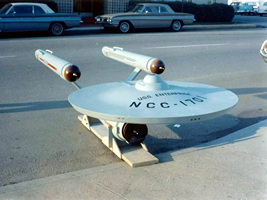
 Completed Enterprise on 29 Dec 1964
Completed Enterprise on 29 Dec 1964
